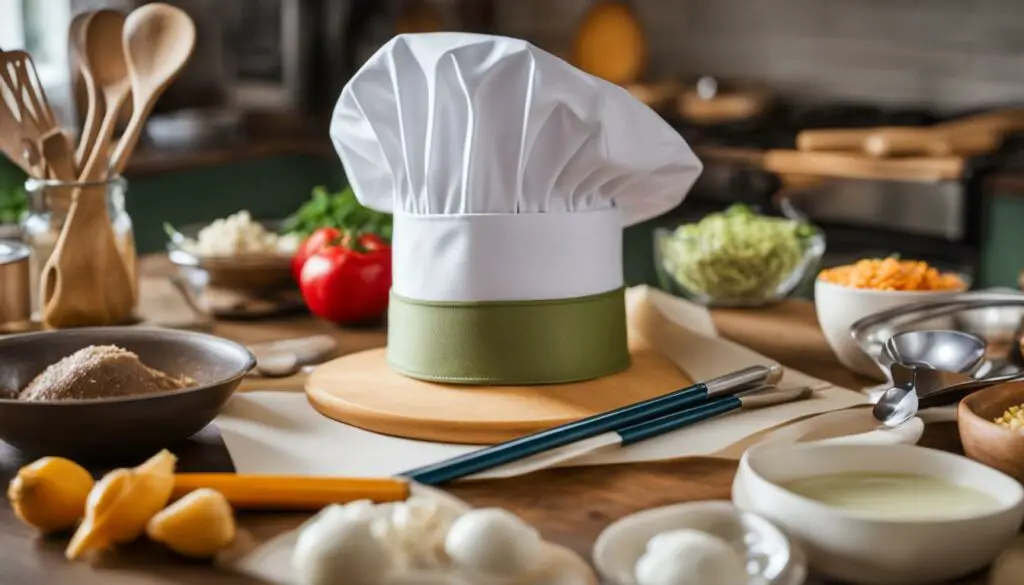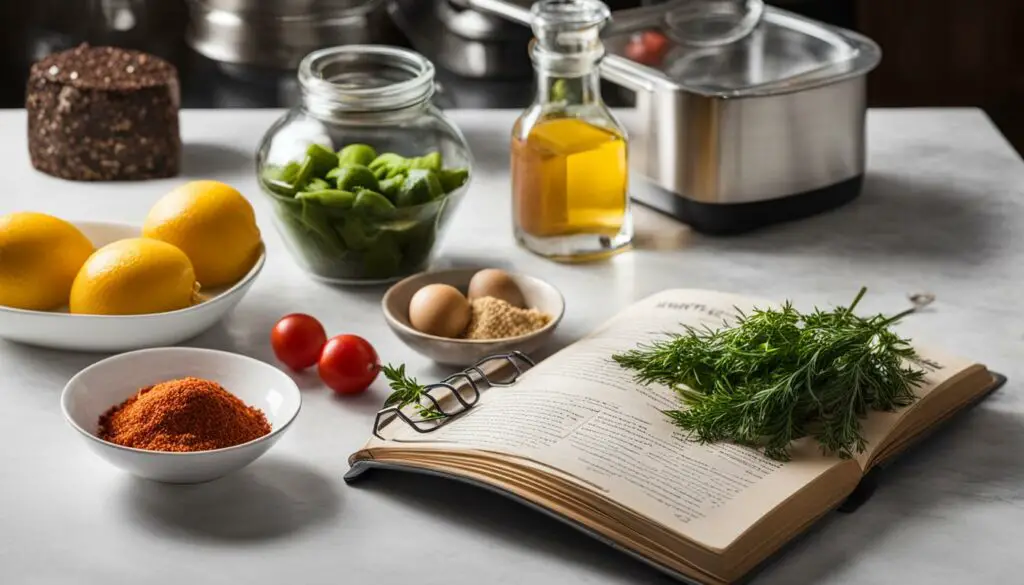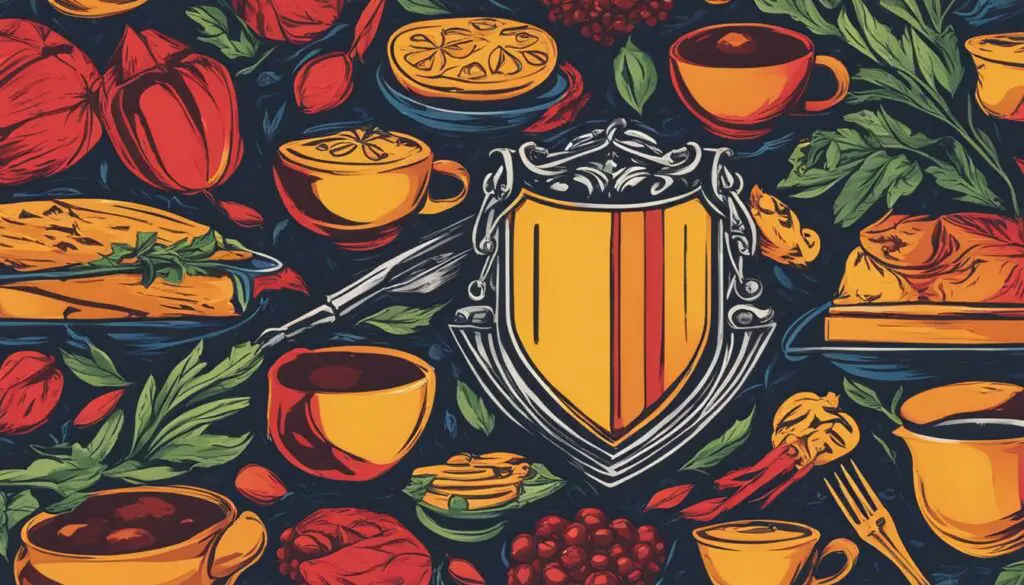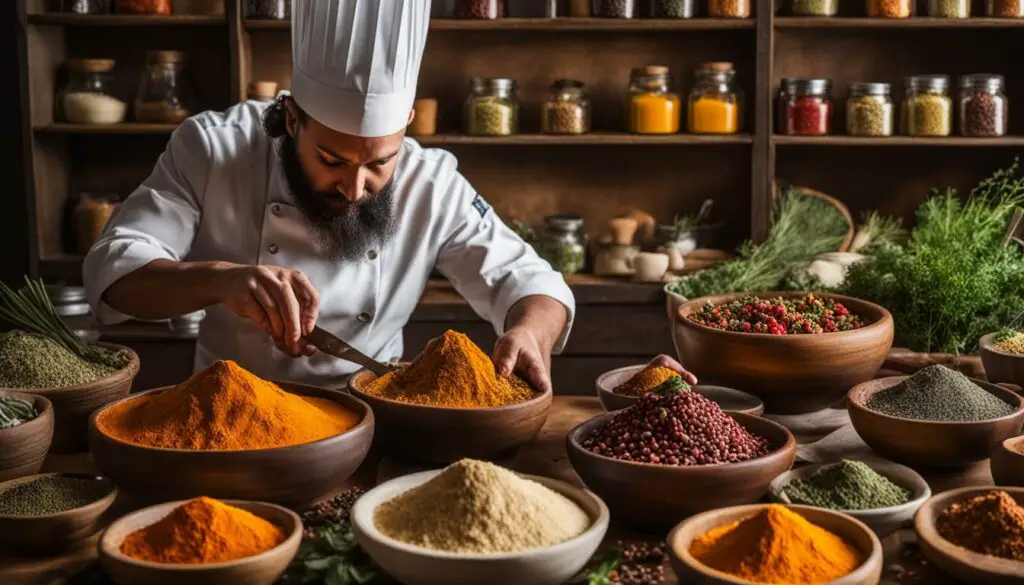Originally posted on December 13, 2023 @ 6:13 am
When it comes to copyright protection for recipes, the subject can be quite complex and often sparks debates. While the ingredient list itself may not be eligible for copyright protection, there are other elements of a recipe that can be safeguarded. These can include the written instructions, accompanying photographs, and even collections of recipes such as cookbooks.
Understanding the intricacies of recipe copyright laws is essential for any culinary enthusiast or professional looking to protect their original creations. In this article, we will explore the definition of a recipe and its various components. We will also delve into the forms of copyright protection available for written text and media, as well as the steps you can take to ensure your recipes are adequately protected. Furthermore, we will address common misconceptions surrounding copyright and reveal other forms of intellectual property protection that can be utilized.
Contents
- 1 The Definition of a Recipe and Its Components
- 2 Copyright Protection for Written Text and Media
- 3 Steps to Ensure Copyright Protection for Recipes
- 4 Copyright Misconceptions: Changing Ingredients and Attribution
- 5 Copyright Protection for Recipe Collections
- 6 Copyright vs. Other Forms of Intellectual Property Protection
- 7 Copyrightability of Individual Recipes
- 8 Patent Protection for Recipes
- 9 Trademark Protection for Recipe Names and Brands
- 10 Trade Secrets for Recipe Protection
- 11 Conclusion
- 12 FAQ
- 12.1 Can you copyright a recipe?
- 12.2 What is a recipe and its components?
- 12.3 What can be protected under copyright?
- 12.4 How can I ensure copyright protection for my recipes?
- 12.5 Can I use a recipe if I change a certain number of ingredients?
- 12.6 Can recipe collections be protected by copyright?
- 12.7 What are the different types of intellectual property protection for recipes?
- 12.8 Are individual recipes eligible for copyright protection?
- 12.9 Are recipes commonly protected by patents?
- 12.10 How does trademark protection apply to recipes?
- 12.11 How can trade secrets protect recipes?
- 13 Source Links
Key Takeaways:
- Copyright protection for recipes extends beyond just the ingredient list.
- The written text, photographs, and collections of recipes can be eligible for copyright protection.
- Taking steps such as using copyright symbols, developing a distinct voice, and seeking permission can help protect your published recipes.
- Changing a recipe’s ingredients does not exempt it from copyright infringement.
- A trademark can protect the name and branding associated with a recipe.
The Definition of a Recipe and Its Components
A recipe is a formula for cooking or preparing food that consists of various components. The essential elements of a recipe include the following:
Ingredients
The ingredients are the raw materials used in the recipe. They can include various food items, such as fruits, vegetables, meats, spices, and other flavorings. The combination of ingredients defines the flavors and textures of the final dish.
Directions
The directions provide step-by-step instructions for preparing the dish. They outline the specific techniques, cooking methods, and timings required to achieve the desired result. The directions ensure that the dish is prepared correctly and consistently.
Headnotes
Headnotes are additional context, tips, or personal anecdotes included in a recipe. They can provide background information, alternative variations, serving suggestions, or insights from the recipe creator. Headnotes add depth and personality to the recipe, enhancing the overall cooking experience.
While ingredient lists themselves are not eligible for copyright protection, other elements of a recipe, such as the directions, headnotes, and accompanying media, can be protected. Recipes are considered valuable intellectual property due to their unique combination of flavors, techniques, and creative presentation.
Copyright Protection for Written Text and Media

While ingredient lists themselves cannot be copyrighted, the written text of a recipe, including the directions, headnotes, and additional content, can be protected by copyright. Similarly, photographs and videos accompanying a recipe can also be protected. This means that if someone were to reproduce your recipe or use your photographs without permission, they could be infringing on your copyright.
When it comes to written text, the unique combination of words and the creative expression in the recipe instructions, headnotes, and additional content can be protected by copyright. This includes any original descriptions, personal anecdotes, or tips you provide alongside the recipe. By copyrighting your written text, you can assert your ownership and prevent others from using it without your permission.
Photographs are another valuable element of a recipe that can be protected by copyright. The visual representation of the dish, the styling, lighting, and composition of the photograph are all part of the creative expression that deserves protection. Whether it’s a mouthwatering image of a perfectly baked pie or a vibrant close-up of fresh ingredients, your recipe photographs can be safeguarded against unauthorized use.
Recipe videos have become increasingly popular in the digital age, and they too can be subject to copyright protection. The storytelling, visual aesthetics, editing techniques, and the entire production process are all creative aspects that should be protected. So, if you’ve put your time and effort into producing engaging recipe videos, copyright can help you maintain exclusive control over your content.
By securing copyright protection for your written text, photographs, and videos, you not only have legal recourse if someone infringes on your rights, but you also establish your ownership and reputation as a creator. This can be especially important for chefs, food bloggers, and cookbook authors who rely on their original recipes and accompanying media for their livelihood.
The Importance of Copyright Notices
To further protect your copyrighted recipes, photographs, and videos, it is essential to include copyright notices on your work. Copyright notices typically consist of the copyright symbol (©), the year of publication, and the name of the copyright owner. This simple addition to your recipe, photograph, or video can serve as a warning to others that your work is protected by copyright and should not be used without permission.
Including copyright notices also facilitates communication with individuals who may have an interest in using your content. It clarifies that you are the rightful copyright owner and provides a clear path for obtaining proper authorization. This proactive approach can help you assert your rights and avoid potential conflicts or misunderstandings in the future.
In summary, while ingredient lists cannot be copyrighted, the written text of a recipe, as well as the accompanying photographs and videos, can be protected. Copyright registration and the inclusion of copyright notices can help safeguard your creative works and ensure that others do not use or reproduce them without your permission.
Steps to Ensure Copyright Protection for Recipes

If you publish recipes, it’s important to take steps to protect your work from copyright infringement. By implementing these measures, you can safeguard your original recipes and ensure that others cannot use or reproduce them without permission.
- Include more than just the ingredient list: While ingredient lists themselves are not eligible for copyright protection, other elements of a recipe can be. To increase the copyrightability of your recipes, make sure to include additional creative content such as written instructions, cooking techniques, and personal anecdotes. This will add substantial literary expression to your recipes, making them more eligible for copyright protection.
- Develop a distinct voice: Creating a unique and recognizable voice for your recipes can further enhance their copyrightability. Consider adding a personal touch or a specific writing style that sets your recipes apart from others. This will make it easier to establish that your recipes have originality and are not merely a factual list of ingredients and instructions.
- Use copyright symbols and notices: Including copyright symbols (©) and notices in your recipes can help deter potential infringers. Place a copyright symbol followed by the year of publication and your name at the bottom of each recipe. Additionally, include a clear copyright notice stating that your recipes are protected by copyright law.
- Request permission for reposting: If you come across a recipe that you would like to share, always seek permission from the original creator before reposting or reproducing it. This is not only a respectful practice but also ensures that you are not infringing on someone else’s copyright. Remember, giving credit to the original source is not a substitute for obtaining permission.
By following these steps, you can take proactive measures to protect your published recipes and deter potential infringements. The combination of creative content, a distinct voice, copyright symbols and notices, and obtaining permission for reposting will significantly strengthen your recipe’s copyright protection.
Copyright Misconceptions: Changing Ingredients and Attribution

There is a common misconception that changing a certain number of ingredients in a recipe allows you to use it without permission. However, this is not true, as even minor changes do not exempt you from copyright infringement. It’s crucial to respect the original creator’s rights and obtain proper permission when using their recipe as the basis for your own culinary creations.
Attribution is also an essential aspect of recipe usage. Regardless of whether copyright is a concern, it is important to attribute recipes to their original source as a matter of ethics and common courtesy. This way, you acknowledge the hard work and expertise of recipe creators, and encourage a respectful and supportive culinary community.
When it comes to changing ingredients in a recipe, it’s important to remember that the expression of a recipe extends beyond the ingredient list itself. The combination of specific ingredients and their measurements can be seen as part of the original creator’s creative vision. Modifying these elements without permission may still infringe on copyright, as it alters the core aspects of the recipe.
By respecting copyright and providing proper attribution, you contribute to a thriving and respectful recipe community, ensuring that recipe creators receive the recognition they deserve.
Copyright Protection for Recipe Collections

Collections of recipes, such as cookbooks, possess copyright protection as a whole. This means that even if the individual recipes are in the public domain, the collection itself is safeguarded under copyright law. The selection, arrangement, and coordination of the recipes in the collection are considered creative elements that qualify for copyright protection.
Developing a cookbook involves more than just compiling a list of recipes. The thoughtfully curated selection and organization of recipes, along with any accompanying text or images, embody a unique and original expression of creativity. Therefore, as the creator of a recipe collection or cookbook, you are entitled to copyright protection for your work.
Obtaining copyright protection for a recipe collection can provide various benefits. It gives you the exclusive right to reproduce, distribute, and display the entire collection, preventing others from using it without your permission. This legal protection ensures that your hard work and creativity are recognized and respected.
When it comes to copyrighting a recipe collection, it’s crucial to ensure that your compilation is original and not an exact replica of an existing cookbook. Your collection should feature a distinctive selection and arrangement of recipes, showcasing your creative choices and culinary expertise.
Benefits of Copyright Protection for Recipe Collections
| Benefits | Description |
|---|---|
| Exclusive Rights | You have the sole authority to reproduce, distribute, and display your recipe collection. |
| Recognition | Copyright protection acknowledges and validates your creative efforts and culinary expertise. |
| Prevention of Unauthorized Use | Copyright protection restricts others from using your recipe collection without your permission. |
| Monetary Benefits | By controlling the use of your recipe collection, you can potentially generate revenue through licensing and royalties. |
| Preservation of Intellectual Property | Copyright protection ensures that the unique expression of your creative work is legally acknowledged and safeguarded. |
In conclusion, copyright protection offers valuable safeguards for recipe collections, granting you control over your creative work and preventing unauthorized use. By understanding the principles of copyright law and taking the necessary steps to protect your recipe collection, you can confidently share your culinary creations with the world while preserving the integrity of your original work.
Copyright vs. Other Forms of Intellectual Property Protection

When it comes to protecting recipes with intellectual property, creators have various options beyond copyright. Trademark, patent, and trade secret laws offer additional forms of protection depending on the specific aspects being safeguarded.
Copyright vs. Trademark
Copyright protects the expression of a recipe, such as the written instructions, photographs, and accompanying media. On the other hand, trademarks protect names and logos associated with a recipe, creating brand recognition and preventing competitors from using similar names for dishes.
Copyright vs. Patent
While patents are commonly used to protect unique inventions and methods, they can be less common for recipes. Patents may be utilized for innovative cooking techniques specific to a recipe. However, due to the challenges associated with patenting recipes and the disclosure of the recipe to the public, copyright tends to be the primary form of protection for recipes.
Copyright vs. Trade Secret
Trade secrets can be employed to protect the confidential information of recipes. By treating the recipe as a trade secret, creators can limit access to the recipe through strict nondisclosure agreements. However, trade secrets can be challenging to enforce and require measures to prevent reverse-engineering by individuals with scientific backgrounds.
Each form of intellectual property protection offers different benefits and considerations for recipe creators. By understanding copyright, trademark, patent, and trade secret laws, creators can choose the most suitable approach to protect their culinary creations.
| Intellectual Property | Protection Provided |
|---|---|
| Copyright | Protection of written instructions, photographs, and media accompanying the recipe |
| Trademark | Protection of recipe names and logos, preventing the use of similar names for dishes |
| Patent | Less common for recipes, protection of unique cooking methods specific to a recipe |
| Trade Secret | Protection of the confidential information of recipes through strict nondisclosure agreements |
Copyrightability of Individual Recipes

When it comes to copyright protection, individual recipes can be tricky to safeguard. To be eligible for copyright, a recipe needs to exhibit more than just a basic list of ingredients and instructions. It must showcase substantial literary expression, which can include creative descriptions, personal anecdotes, or detailed instructions that reflect the author’s unique style and voice.
While the ingredient list itself is not copyrightable, the additional elements that contribute to the overall expression of the recipe can be protected. These creative components lend a sense of originality and creativity to the recipe, making it eligible for copyright.
For example, consider a recipe that includes engaging descriptions of the flavor profile, origin, or cultural significance of the dish. These expressive and creative elements can elevate a recipe beyond a mere set of instructions and give it the necessary literary expression to qualify for copyright protection.
Similarly, personal anecdotes or stories related to the recipe can add a unique touch and demonstrate the author’s creativity. Detailed instructions that go beyond the basics and provide additional tips and insights can also contribute to the copyrightability of a recipe.
However, it’s important to note that not all recipes meet the threshold for copyright protection. Simple recipes that lack substantial literary expression may fall outside the scope of copyright law. Additionally, copyright protection only extends to the specific expression of a recipe, not to the underlying idea or concept itself.
For example, a recipe for chocolate chip cookies may not be copyrightable, as it is a common and well-known idea. However, a recipe that includes unique flavor combinations, a specific baking technique, and creative descriptions may be eligible for copyright protection.
By understanding the factors that contribute to the copyrightability of recipes, creators can ensure that their culinary creations receive the protection they deserve. Adding elements of creativity and literary expression can help elevate a recipe to a level that is eligible for copyright protection, safeguarding the hard work and ingenuity that went into its creation.
Patent Protection for Recipes

While copyright protection is commonly sought for recipes, patent protection is less frequently pursued due to various challenges and requirements. Recipes must meet the novelty requirement, meaning they must be completely new and different from existing recipes, to be eligible for patent protection. However, proving the novelty of a recipe can be complex, as there are countless recipes in existence.
Obtaining a patent for a recipe can also be expensive and time-consuming. The process typically involves hiring patent attorneys or agents, conducting extensive research, and filing a patent application with the relevant intellectual property office. The costs associated with patenting, including legal fees and filing fees, can add up quickly.
Furthermore, it’s important to consider that obtaining a patent requires disclosing the recipe to the public. Patents are public documents that include detailed descriptions of the invention, which in the case of recipes would mean revealing the entire recipe and its unique features. This disclosure may not be desirable for recipe creators who wish to keep their recipes secret or retain a competitive advantage.
Overall, due to the challenges, costs, and time considerations involved, patent protection is not typically pursued for recipes. Instead, creators often rely on other forms of intellectual property protection, such as copyright or trade secrets, to safeguard their recipes.
Trademark Protection for Recipe Names and Brands
While copyright protection focuses on the content of a recipe, trademark protection offers a unique approach to safeguarding recipe names and food brands. While it doesn’t prevent others from copying a recipe, trademark registration can help protect the distinctive name and branding associated with a recipe.
In the culinary world, recipe names can hold significant value, helping to distinguish a dish and make it memorable to consumers. By securing a trademark for a recipe name, you can establish exclusive rights to its use in specific contexts, preventing competitors from using a similar name for their dishes.
Not only does this protect your recipe from being confused with others, but it also allows you to build brand recognition and consumer trust. Consumers who have a positive experience with your recipe can associate it with a specific name, leading to increased loyalty and recurring business.
In addition to recipe names, trademark protection can also extend to food brands that encompass multiple recipes or food products. By trademarking your food brand, you can create a unique identity in the market, protecting it from imitation and unauthorized use.
Trademark protection for recipe names and food brands provides a legal framework to safeguard your culinary creations beyond copyright. It offers valuable tools to establish your brand presence, preserve consumer confidence, and deter potential infringers from exploiting your recipes for their own gain.
To illustrate the importance of trademark protection for recipe names and brands, consider the following table:
| Trademarked Recipe Name | Unprotected Recipe Name |
|---|---|
| TastyTreats® | DeliciousDishes |
| GourmetGrains® | PremiumPantries |
| SizzleSensations™ | FlavorfulFusion |
In the table above, trademarked recipe names are on the left, while unprotected recipe names are on the right. By securing trademark protection, the owners of these recipe names can assert their legal rights, preventing competitors from using similar names that may confuse customers or dilute the distinctive qualities of their dishes.
By understanding the benefits of trademark protection for recipe names and food brands, you can strategically safeguard your culinary creations, build a strong brand presence, and effectively communicate your unique offerings to consumers.
Trade Secrets for Recipe Protection
Trade secrets can be a valuable tool for protecting recipes, treating them as confidential information that must be safeguarded. By keeping the recipe as a trade secret, you can limit access to it and maintain a competitive advantage in the culinary world. However, enforcing trade secret laws can be challenging, especially when individuals with scientific backgrounds attempt to reverse-engineer the recipe.
To ensure the protection of your recipe as a trade secret, it is crucial to implement nondisclosure and noncompetition agreements. These legal agreements help establish clear boundaries and restrictions for those who have access to the recipe, preventing unauthorized disclosure or use. By requiring individuals to sign these agreements, you can establish a legal framework to hold them accountable if they violate the terms.
Despite the use of trade secret agreements, it is important to note that reverse-engineering recipes remains a potential risk. Skilled individuals may attempt to analyze and replicate the recipe by studying the final product and its ingredients. This process could result in them using the recipe without violating trade secret laws.
Trade secrets can be a viable alternative for protecting recipes, especially when other forms of intellectual property are not suitable or available. The ability to conceal the recipe as confidential information can provide a level of protection against competitors, as long as proper precautions are taken.
Next, we’ll compare copyright, trademark, and patent protection to shed light on their differences and explore their relevance to recipe protection.
Conclusion
In conclusion, the copyright protection for recipes is a nuanced and multifaceted subject. While individual recipes themselves may not be eligible for copyright protection, other elements such as written instructions, photographs, and collections of recipes can be protected. It is important for recipe creators to understand the different forms of intellectual property laws, such as copyright, trademark, patent, and trade secret, in order to effectively safeguard their culinary creations.
Copyright laws can protect the written text of a recipe, including the directions, headnotes, and additional content. Additionally, photographs and videos accompanying the recipe can also be protected. Trademark laws can safeguard the name and branding associated with a recipe, while patent protection is less commonly pursued for recipes due to the novelty requirement and cost considerations. Trade secrets can be used to keep recipes confidential, but enforcement can be challenging.
By having a clear understanding of the various forms of intellectual property protection, recipe creators can take steps to ensure their creations are safeguarded. From developing a unique voice for their recipes to using copyright symbols and notices, every effort should be made to protect the creative elements of the recipe. While individual recipes themselves may not be eligible for copyright protection, the combination of copyrightable elements and other forms of intellectual property can help recipe creators protect their work and maintain the originality of their culinary creations.
FAQ
Can you copyright a recipe?
While ingredient lists themselves are not eligible for copyright protection, other elements of a recipe, such as written instructions and accompanying photographs, can be protected.
What is a recipe and its components?
A recipe is a formula for cooking or preparing food. It includes a list of ingredients, directions, and often includes headnotes that provide additional context or tips.
What can be protected under copyright?
The written text of a recipe, including the directions, headnotes, and additional content, can be protected by copyright. Photographs and videos accompanying a recipe can also be protected.
How can I ensure copyright protection for my recipes?
Steps to ensure copyright protection include including more than just the ingredient list, developing a distinct voice, using copyright symbols and notices, and requesting permission for reposting another recipe.
Can I use a recipe if I change a certain number of ingredients?
Changing ingredients does not exempt you from copyright infringement. It’s important to attribute recipes to their original source as a matter of ethics and common courtesy.
Can recipe collections be protected by copyright?
Yes, collections of recipes, such as cookbooks, can be protected by copyright as a whole. The selection, arrangement, and coordination of the recipes in the collection are considered creative elements that qualify for copyright protection.
What are the different types of intellectual property protection for recipes?
Recipes can be protected under copyright, trademark, patent, or trade secret laws. Copyright protects the expression of a recipe, trademarks protect names and branding, patents may be used for unique cooking methods, and trade secrets protect confidential information.
Are individual recipes eligible for copyright protection?
Individual recipes themselves are often difficult to protect under copyright. To be eligible for protection, a recipe must exhibit substantial literary expression beyond a mere list of ingredients and directions.
Are recipes commonly protected by patents?
Patent protection for recipes is less common due to the challenges of meeting the novelty requirement and the expense of obtaining a patent. Patents also require disclosing the recipe to the public.
How does trademark protection apply to recipes?
Trademark protection can’t prevent others from copying a recipe, but it can protect the name and branding associated with it. Unique recipe names and logos used in marketing food products can be registered as trademarks.
How can trade secrets protect recipes?
Trade secrets can protect recipes by treating them as confidential information, but enforcing trade secret laws can be challenging. Non-disclosure agreements can help limit access to the recipe.








